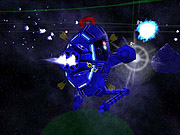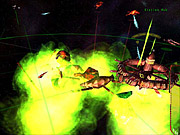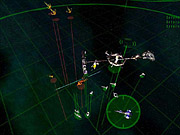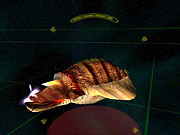"Venture into oblivion." That unfortunate tagline has been applied to Far Gate, a new 3D real-time strategy title set in space from neophyte Seattle development house Super X Studios. The phrase inadvertently sums up the experience of playing Far Gate--the game's difficult interface, unmanageable camera angles, and many technical problems all but overshadow Far Gate's various original qualities.

As with all strategy games featuring fully three-dimensional playing fields, Far Gate's success or failure hinges on the usability of its interface. Letting the player quickly and effectively maneuver ships in a 3D environment portrayed on a flat 2D monitor is a serious challenge for any developer to overcome. Unfortunately, while Far Gate's interface seems both attractive and functional at first glance--courtesy of foldaway panels that keep track of current orders and handle the control of individual units, squadrons, and special commands--extended play uncovers a great many shortcomings in its design. The panels, for instance, line all sides of the screen, making it easy to open them up when you're actually just trying to scroll the camera. Locking them in an open position eliminates the problem, though doing this obscures a good portion of the screen. (Freezing them in their folded-back position would likely be a better option, were it available, as you can still read the information on them in this state, and they don't get in the way as much.) Turning the interface off completely and making do with hotkeys and the mouse is really the only way to proceed.
The camera perspective is equally tricky to operate. Zooming in and out with the mousewheel seems to change the viewing plane, so attempting to get up close and personal with a vessel or structure requires some additional fiddling, which isn't exactly conducive to guiding ships into the heat of battle. Right-clicking on a unit or a squadron for a close-up is even more frustrating. One click takes you in so tight that you can't see anything else (which is effective if you want to watch a battle from the chase-mode camera), and two clicks don't move you far enough back to get a good look at the situation. Hitting the Tab key provides a tactical overview of the entire system, but even this is relatively useless since you're placed so far away from everything that it's impossible to see what's going on. Moving the cursor over individual units and obstacles such as planets and asteroids brings up an telescope-like circle that reveals more of the map, though these bubbles appear right on top of your vessels and thus cover more than they reveal. At any rate, most ships are so tiny that you won't know that they're present at all unless you search for them with the cursor. Maneuvering squadrons on this tactical screen is also trying because the left mouse button both selects units and assigns them orders to move. As a result, you'll often select a new unit by mistake when actually trying to move one.

Frustrations caused by the interface will be worsened by Far Gate's general lack of technical polish. Load times are extremely long when starting a mission, lasting a full minute or more, even on a system that's well above the recommended minimum. This wouldn't be quite as bad if the game actually loaded, as it frequently doesn't. While loading saved games in the solo campaign, the game regularly crashes to the desktop without so much as an error message. Starting a new mission routinely required two or more attempts, the first one almost always resulting in a crash to the Windows desktop. Far Gate also crashes during regular gameplay. These bugs can crop up at any time, sending you abruptly back to Windows with only a beta tester's log report to show for it.
That these issues are so troublesome is a real shame, since some of the core concepts behind Far Gate are solid. The story is well told and there are three distinct playable factions in the game that employ wholly disparate units and structures. In the 17 missions of the brief solo campaign, you play as Jacob Viscero, a black marketeering space captain blackmailed into assisting with the human colonization of the Proxima Centauri star system. No sooner are these efforts underway than you're presented with some strange inconsistencies regarding why you're in the star system at all and the trustworthiness of your own military. Making matters worse, a wormhole opens and you're promptly under attack by the nue-guyen, squidlike creatures that treat deep space like an ocean. The standard real-time strategy triumvirate of races is soon filled out by the entrodii, crystalline beings that specialize in a sort of biokinetic energy weaponry. Over the course of the game, you travel to different systems through wormholes in an effort to defeat the enemy and find a peaceful home for the human colonists.
Each of the three races uses diversified technology, units, and structures that set it apart from its rivals. Mechanically inclined terrans have diverse hardware that makes them jacks-of-all-trades. Their ships balance speed, armor, and firepower in nearly every way. There is nothing surprising in the human arsenal, which is made up of light fighters and gunboats at first and more powerful ships such as carriers and bombers in the later stages. The same can't be said for the nue-guyen. These rather disgusting aliens organically mimic technology with living "ships" such as the blood worm, which sprays digestive acid onto enemies; the drakken, which can spit flammable gel; and the sirocco, which breathes corrosive clouds of bacteria. All the nue-guyen are symbiotic, so their individual attacks are more powerful when they're gathered in significant numbers. Eels, for example, produce stronger electrical discharges when in packs. Nue-guyen are also generally quite agile and tough, and concentrated fire is often required to take them out. Entrodii are stronger offensively than the other two races, due to their use of potent energy weapons. Vessels like the shardikru and the shrike are little more than plasma cannons capable of devastating foes with a single blast. The drawback to this is a lack of maneuverability that makes them vulnerable.

All factions build bases in space that can be expanded with the addition of attached structures designed for the construction or hatching of specific unit types. The terran prefab kit turns itself into a destiny-class station hub that is the center of other buildings, such as pod bays, shipyards, and hangars. Nue-guyen and entrodii bases are constructed in the same way, although they aren't so much built as they are grown. Nue-guyen facilities revolve around a "heart," and they include additions such as hives and hatcheries, while the entrodii start with an energy-producing spire that can power the creation of offshoots like the precipitator and crystallizer. In all cases, if the central hub unit is destroyed, everything attached to it goes up in flames. All three civilizations gather the same resources from asteroids floating through the game's many planetary systems. This is largely automated, so micromanagement isn't a concern. With the terrans, for example, all you have to do is build a station hub and pod bay near an asteroid field. From there, pods automatically collect the resources for you. Entrodii resource gathering is even more basic, as the collector beams the material gathered directly to the race's spire.
These differences don't have as much of an effect on the solo game as you might expect. All sides move at a sluggish pace. Ships move slowly and time cannot be accelerated, so you'll often wait for minutes while vessels go about their patrolling or move to engage the enemy. Computer opponent artificial intelligence is quite poor, as both the nue-guyen and the entrodii will often lack the ability to properly react to your movements. As a result, the solo campaign missions are fully scripted and laid out like puzzles that need to be solved. Many of the situations simply can't be handled the first time through a mission. You'll need to replay most missions three or four times in order to learn how to counter what the enemy is going to do. Learning what is about to happen is really the only way to succeed in many of the assignments, especially after the first third of the campaign.
It's easy to suspect that this deficient artificial intelligence was behind the unfortunate decision to ship Far Gate without a skirmish mode. Although you can engage in single missions against the computer, the only missions available are the ones that you've already completed in the course of the campaign, and you can only play them on the terran side. Replayability is bolstered somewhat by a campaign editor, six multiplayer-only maps, and matching service support through GameSpy and Mplayer, but it's hard to imagine too many players going online without the initial enticement provided by skirmishing against the computer.

Far Gate's inconsistent quality extends to its graphics and sound, although these elements are generally quite good. Graphically, the game has a unique appearance that is both contemporary and retro. Some aspects of the artwork are spectacular. Ship designs are fully evocative of the races that use them. Terran vessels feature moving mechanical parts like recoiling cannons and rotating sensor dishes, nue-guyen look like various octopi swimming through space, and the entrodii ships glisten and radiate a powerful glow. Other components aren't quite so attractive. The background is ablaze with hues that seem out of place. Colorful nebulae overwhelm both the blackness of space and the stars, as do asteroids that shine like nuggets of gold and silver. Characters are represented by cartoonish head-and-shoulder pictures that seem out of place.
The quality of the audio is also inconsistent. Atmospheric sounds include nice touches like the thump of a terran cannon, the crackle of radio transmissions when you get close to a human hub, and the dolphinlike squeal of a nue-guyen. Unfortunately, all this is weighed down with a musical score that is absolutely bizarre. It's reminiscent of an old-school progressive rock instrumental, filled with chiming bells, out-of-place horns, and lots of faux spooky notes from a recorder. It deserves points for originality, though the overall effect is so jarring that it can distract you from the actual game.
Judging Far Gate as the first effort from an independent developer, it can be seen as a successful first step--it features many promising elements that the developer can improve and expand on in future endeavors. But judging Far Gate as a commercial product in the fiercely competitive real-time strategy market doesn't give nearly as favorable of an impression. Ultimately, in spite of the game's original qualities, there are just too many other, better choices available to make it worthwhile for most real-time strategy game players to settle for Far Gate and its many problems.